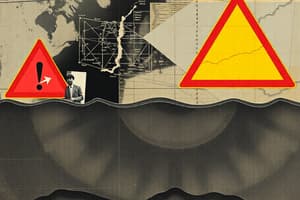Podcast
Questions and Answers
Who invented the Richter Scale?
Who invented the Richter Scale?
- California Institute of Technology
- Beno Gutenburg
- Seismologists
- Charles Richter (correct)
What does the Richter Scale measure?
What does the Richter Scale measure?
- Magnitude of an earthquake (correct)
- Amount of destruction to an area after an earthquake
- Depth of an earthquake's epicenter
- Frequency of earthquakes in a region
What is the primary purpose of the Richter Scale?
What is the primary purpose of the Richter Scale?
- To measure the amount of ground shaking and energy released from an earthquake (correct)
- To predict the occurrence of earthquakes
- To study the effects of earthquakes on the environment
- To measure the depth of earthquakes
What did Charles Richter initially study before getting involved in seismology?
What did Charles Richter initially study before getting involved in seismology?
Where was Charles Richter studying when he was approached to work in a seismology lab?
Where was Charles Richter studying when he was approached to work in a seismology lab?
What aspect of earthquakes does the Richter Scale not measure?
What aspect of earthquakes does the Richter Scale not measure?
For what type of earthquakes was the Richter scale originally focused on?
For what type of earthquakes was the Richter scale originally focused on?
What is the main purpose of the Richter scale?
What is the main purpose of the Richter scale?
Why is the seismograph important in measuring earthquake magnitude?
Why is the seismograph important in measuring earthquake magnitude?
What is a limitation of the Richter scale for higher magnitude earthquakes?
What is a limitation of the Richter scale for higher magnitude earthquakes?
How does the energy released by earthquakes change with each unit increase on the Richter scale?
How does the energy released by earthquakes change with each unit increase on the Richter scale?
What is the main difference between the Richter scale and the moment magnitude scale?
What is the main difference between the Richter scale and the moment magnitude scale?
What is seismic activity in relation to earthquakes?
What is seismic activity in relation to earthquakes?
Why is the Richter scale less accurate for earthquakes with a magnitude of 6.5 and higher?
Why is the Richter scale less accurate for earthquakes with a magnitude of 6.5 and higher?
What does the Richter scale measure?
What does the Richter scale measure?
Who invented the Richter scale?
Who invented the Richter scale?
What is the primary purpose of the Richter scale?
What is the primary purpose of the Richter scale?
What sparked Charles Richter's interest in studying earthquakes?
What sparked Charles Richter's interest in studying earthquakes?
Why is the Richter scale not used to measure the amount of destruction caused by an earthquake?
Why is the Richter scale not used to measure the amount of destruction caused by an earthquake?
What was Charles Richter's original field of study before entering seismology?
What was Charles Richter's original field of study before entering seismology?
Why did Charles Richter initially agree to work in a seismology lab at California Institute of Technology?
Why did Charles Richter initially agree to work in a seismology lab at California Institute of Technology?
What type of earthquakes does the Richter scale primarily measure?
What type of earthquakes does the Richter scale primarily measure?
Why is the Richter scale less accurate for earthquakes with a magnitude of 6.5 and higher?
Why is the Richter scale less accurate for earthquakes with a magnitude of 6.5 and higher?
What is the main difference between the Richter scale and the moment magnitude scale?
What is the main difference between the Richter scale and the moment magnitude scale?
How does the energy released by earthquakes change with each unit increase on the Richter scale?
How does the energy released by earthquakes change with each unit increase on the Richter scale?
What is the primary purpose of the moment magnitude scale?
What is the primary purpose of the moment magnitude scale?
What does a seismograph do in relation to earthquakes?
What does a seismograph do in relation to earthquakes?
What is seismic activity in relation to earthquakes?
What is seismic activity in relation to earthquakes?
What does the Richter scale measure?
What does the Richter scale measure?
Flashcards are hidden until you start studying




